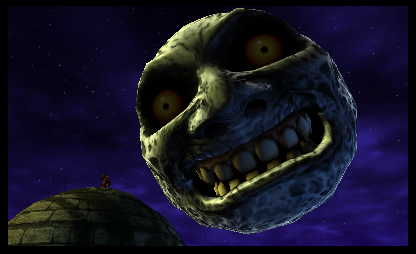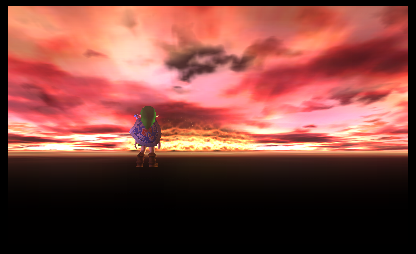Dawn of the First Day: Why Majora’s Mask is Unique
Posted on December 19 2014 by Aaron Suduiko
 Early last month, Nintendo announced in a Nintendo Direct that, over three years after the release of “Legend of Zelda: Ocarina of Time 3D,” “Majora’s Mask” is officially slated for a 3D release at some point next spring. The aim of my project here, a series of analyses entitled With a Terrible Fate, is to reflect on a game which, far beyond being merely the sequel to “Ocarina of Time,” is, in my view, one of the most significant pieces of art in modern times. While the release date for “Majora’s Mask 3D” has not been publicized at this point, my goal is to write regular reflections on different facets of the game, in the hopes that, by the time it is released, I will have articulated just what about this game strikes me as irrevocably moving.
Early last month, Nintendo announced in a Nintendo Direct that, over three years after the release of “Legend of Zelda: Ocarina of Time 3D,” “Majora’s Mask” is officially slated for a 3D release at some point next spring. The aim of my project here, a series of analyses entitled With a Terrible Fate, is to reflect on a game which, far beyond being merely the sequel to “Ocarina of Time,” is, in my view, one of the most significant pieces of art in modern times. While the release date for “Majora’s Mask 3D” has not been publicized at this point, my goal is to write regular reflections on different facets of the game, in the hopes that, by the time it is released, I will have articulated just what about this game strikes me as irrevocably moving.
For a place place to start, I wish to reflect on the aspect of form which simultaneously makes “Majora’s Mask” a peerless experiential story, and makes “Final Fantasy: Lightning Returns” generally appalling: in particular, the aspect is one of how narratives operate within an apocalyptic framework. Both of the games in question are framed within the context of the world ending: in “Majora,” the world is set to end in three days, and in “Lightning,” it is set to end in thirteen days. Yet in spite of this apparent similarity between the games, the dynamics of how the inevitable decay of the world is evidenced in each game drastically impacts how and what we draw from the games as players.
The apocalypse of “Lightning” is completely without import to medium of the game. What I mean is this: the game is set up in thirteen sequential chapters, each of which occupies a day leading up to the moment when the universe’s god of light will instigate the apocalypse. The result of the parsing of the apocalypse – and, consequently, the game – into discrete chapters is that the gamer does not have a qualitatively different experience than playing any role-playing game which progresses chronologically, the only difference being that each chapter has a time limit. So there exists no actual sense of the world ending because the apocalyptic design is the same as the design of any similar game with a beginning, middle, and end: the player’s experience of the game will eventually come to a close, but this is not sufficient to impart upon the player a feeling of the game’s metaphysics actually collapsing (if anything, the player is just left feeling aggravated at how choppy the time constraints make the narrative feel).
 Nothing could more starkly contrast with the apocalypse of “Majora,” which is effectively suspended in a constant state of arrival for the vast majority of the game. Irrespective of what Link may do in the game’s world, the clock continually runs down the 72 hours to Termina’s demise. The moon, which Skull Kid aims to launch directly at the world, draws closer to earth with each passing hour. The only way to postpone the inevitable is by playing the mystical Song of Time, which transports Link back to the start of the three day countdown. This universal decay is only eventually stopped at the game’s end when the spirit possessing Skull Ki, Majora, is banished, and Skull Kid is effectively “talked down” from destroying the world. I firmly believe that it is this grounding on which much of the game’s poignancy ultimately rests, but at present I wish to draw out only two implications from it.
Nothing could more starkly contrast with the apocalypse of “Majora,” which is effectively suspended in a constant state of arrival for the vast majority of the game. Irrespective of what Link may do in the game’s world, the clock continually runs down the 72 hours to Termina’s demise. The moon, which Skull Kid aims to launch directly at the world, draws closer to earth with each passing hour. The only way to postpone the inevitable is by playing the mystical Song of Time, which transports Link back to the start of the three day countdown. This universal decay is only eventually stopped at the game’s end when the spirit possessing Skull Ki, Majora, is banished, and Skull Kid is effectively “talked down” from destroying the world. I firmly believe that it is this grounding on which much of the game’s poignancy ultimately rests, but at present I wish to draw out only two implications from it.
1. The game’s metaphysics mirror the reality of Link as perceived by the gamer. It has been noted in the literature (for example, Tom Bissell’s Extra Lives: Why Video Games Matter) that a key feature of the gaming experience is that the player is able to die as a character and differently experience existence within the world through the mechanic of multiple lives. “Majora’s Mask” extends this framework to the entire world, which is constantly in a state of death and rebirth as the player struggles to repair the decay inherent within the most basic structure of Termina.
 2. In comparison to other games, the structure of “Majora” provides a deep exposition of nihilism. Another feature of the medium of games is that the narrative literally will not advance without the player’s input, making games inherently participatory in their storytelling. What is unique about “Majora” is that it effectively turns this premise on its head: the storyline is a juggernaut of fate that depends upon the player, but that advances with or without the player’s input. If the gamer sets Link in the middle of Termina and does nothing but wait, 72 hours pass and the world is obliterated by the moon. What “Majora” has done is establish a nihilistic reality in which the narrative’s entropy is independent of the hero; yet it is by virtue of this heedless entropy that the hero has the opportunity to assert himself and forge a more satisfying end for all the world’s inhabitants, even if the fact that all will end is itself unavoidable.
2. In comparison to other games, the structure of “Majora” provides a deep exposition of nihilism. Another feature of the medium of games is that the narrative literally will not advance without the player’s input, making games inherently participatory in their storytelling. What is unique about “Majora” is that it effectively turns this premise on its head: the storyline is a juggernaut of fate that depends upon the player, but that advances with or without the player’s input. If the gamer sets Link in the middle of Termina and does nothing but wait, 72 hours pass and the world is obliterated by the moon. What “Majora” has done is establish a nihilistic reality in which the narrative’s entropy is independent of the hero; yet it is by virtue of this heedless entropy that the hero has the opportunity to assert himself and forge a more satisfying end for all the world’s inhabitants, even if the fact that all will end is itself unavoidable.
These are all themes to which I will return in greater depth as time unblinkingly passes and I add more posts. But I cannot imagine a better way to stand in contemplation and awe of this game than that of a gaping moon, staunchly descending with the vow to “consume everything” in its path.
Want to follow the analysis and theory? Read on at With a Terrible Fate.
Aaron Suduiko, Phillips Exeter Academy ’13, Harvard University ’17. Studies philosophy with a focus on developing new aesthetic theory with a grounding in the medium of video games. In 2013, he conducted a comparative analysis of role playing paradigms in video games (“Legend of Zelda: Majora’s Mask,” “Nier,” “Dishonored,” and “Deus Ex: Human Revolution”) and plays (“Six Characters in Search of an Author,” “The Man in the Iron Mask,” “Macbeth,” and “Flowers for Algernon.” He is the author of “With a Terrible Fate,”a twice-weekly analysis of “Majora’s Mask” that is published by Zelda Dungeon and is set to continue through the release of the 3D remake this coming spring. Suduiko is reachable at withaterriblefate@gmail.com.



